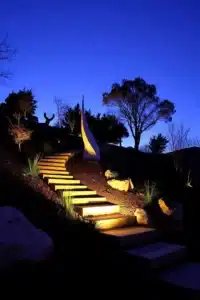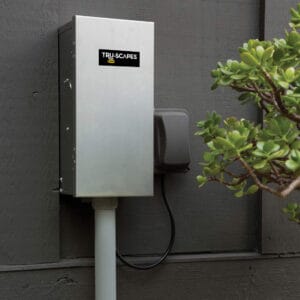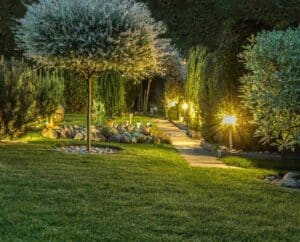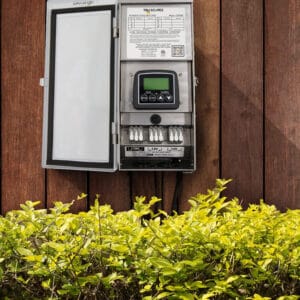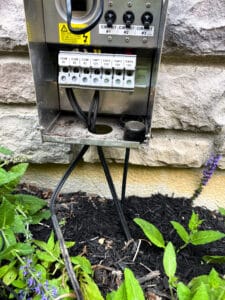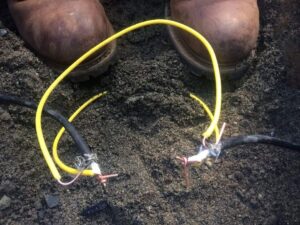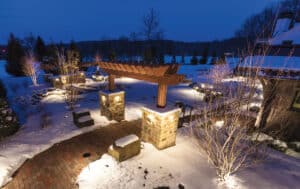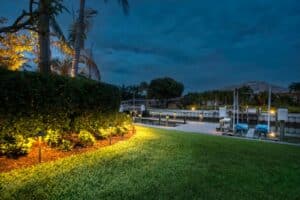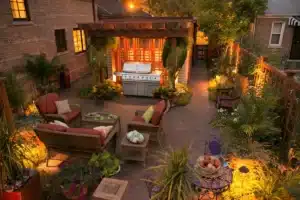Did you know the average homeowner spends over $300 a year on outdoor lighting energy costs? That’s a hefty chunk of change—especially when you consider how a simple switch in bulbs could slash that bill in half. If you’re a middle-aged homeowner in the United States looking to spruce up your yard with landscape lighting solutions, you’ve likely stumbled across two big contenders: LED and halogen. Both can make your garden glow and your pathways pop, but they’re not created equal. So, what’s the real difference between LED and halogen landscape lighting?
By the end of this article, you’ll know exactly how these two options stack up—think energy bills, lifespan, and that all-important curb appeal. Whether you’re illuminating your patio for late-night barbecues or highlighting your favorite oak tree, I’ve got you covered with a clear, no-nonsense comparison from Tru-Scapes. Let’s dive in and shed some light on the subject!
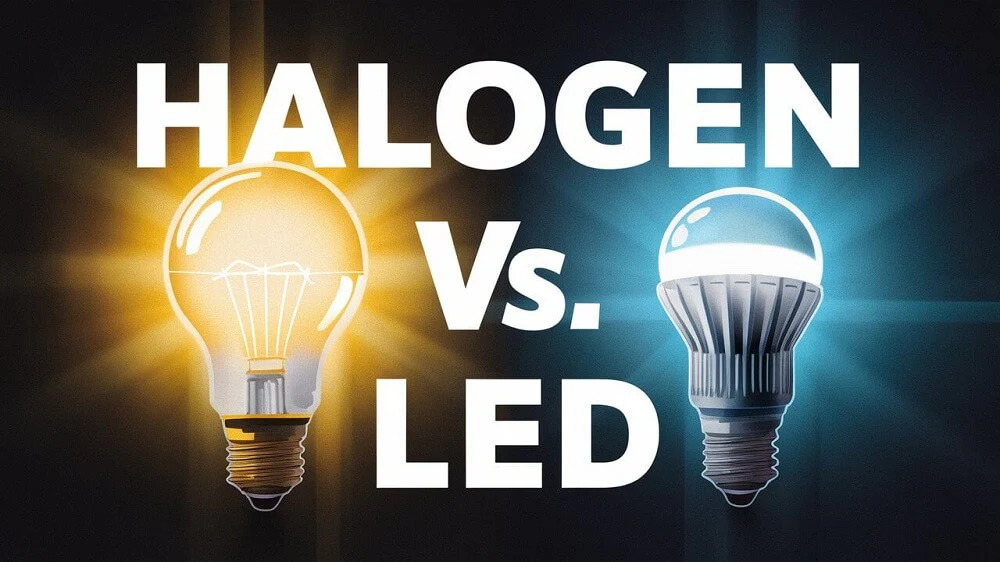
Breaking Down the Basics: LED vs. Halogen Landscape Lighting
First things first—what are we even talking about here? LED stands for “light-emitting diode,” a modern tech marvel that’s taken the lighting world by storm. Halogen, on the other hand, is a tried-and-true type of incandescent bulb, juiced up with a bit of halogen gas to make it brighter and longer-lasting than its old-school cousins. Both are popular for low-voltage landscape lighting, but they bring different strengths to your backyard.
LEDs work by passing electricity through a tiny semiconductor, creating light with almost no wasted energy. Halogen bulbs? They heat a filament until it glows, which is less efficient but still gets the job done. These core differences set the stage for everything else—cost, brightness, durability, you name it. Ready to see how they compare? Let’s get into the nitty-gritty.
Energy Efficiency: Which One Saves You More?
If your electric bill makes you wince every month, this section’s for you. LEDs are the undisputed champs of energy efficiency. They use up to 80% less power than halogen bulbs to produce the same amount of light, as noted in this LED energy savings breakdown from the U.S. Department of Energy. For example, a 10-watt LED can match the brightness of a 50-watt halogen. That’s a game-changer when you’re running lights across your deck, driveway, and flower beds every night.
Halogen bulbs, while brighter per watt than traditional incandescents, still guzzle more juice than LEDs. They’re not terrible—think of them as the reliable pickup truck of lighting—but they won’t win any fuel-efficiency awards. For a typical U.S. homeowner, switching to LED landscape lighting could cut your outdoor energy costs from $300 a year to under $100, depending on usage. Who doesn’t love a little extra cash for that new patio furniture?
Lifespan: How Long Will They Last?
Nobody wants to climb a ladder every few months to replace a burnt-out bulb. Here’s where LEDs really shine. A quality LED landscape light can last 25,000 to 50,000 hours. That’s 10–20 years if you’re running them 6 hours a night! Halogen bulbs? They clock in at 2,000–4,000 hours—solid, but nowhere near LED territory. At that rate, you’re swapping them out every couple of years.
Think of it like this: LEDs are the tortoise, slow and steady, while halogens are the hare, burning bright but fading fast. For busy homeowners who’d rather spend weekends relaxing than tinkering with fixtures, LEDs are a low-maintenance dream. Check out our landscape lighting maintenance tips to keep them shining bright. At Tru-Scapes, we’ve seen customers rave about how our LED systems keep their yards glowing without the hassle of constant upkeep.
Brightness and Color: What’s the Vibe?
Let’s talk aesthetics—because landscape lighting isn’t just about seeing; it’s about feeling. Both LED and halogen bulbs can light up your space beautifully, but they deliver different vibes. Halogen bulbs give off a warm, cozy glow, usually around 2700–3000 Kelvin. It’s that classic, golden hue you might associate with a rustic porch or a welcoming front yard.
LEDs are more versatile. They come in a range of color temperatures, from that same warm 2700K to a crisp, daylight-like 5000K—learn more in our color temperature basics guide. Want your shrubs to look vibrant and green? Go cooler. Prefer a soft, inviting ambiance for your deck? Stick with warm tones. Plus, LEDs often have better color rendering, meaning your flowers and stonework will pop with truer hues. Halogens hold their own, but they can’t match LED’s flexibility.
Here’s a quick comparison:
| Feature | LED | Halogen |
| Color Options | Warm to cool (2700K–5000K) | Mostly warm (2700K–3000K) |
| Brightness | High (lumens per watt) | Moderate |
| Vibe | Customizable | Traditional |
Upfront Cost vs. Long-Term Value
Now, let’s hit the wallet. Halogen bulbs are cheaper upfront—sometimes as low as $5 a pop compared to $15–$25 for a good LED. If you’re just testing out landscape lighting or working with a tight budget, halogen might feel like the easy choice. But hold up—there’s a catch.
LEDs cost more initially, but their energy savings and insane lifespan make them a steal over time. Say you’re lighting a 10-fixture system. With halogen, you’re looking at $50 for bulbs, plus replacements every couple of years, and higher energy bills. Go LED, and that $200 upfront investment pays off with decades of use and lower costs. It’s like buying a quality grill—spend a bit more now, enjoy the benefits for years. Curious? Explore more in Energy Star’s Energy Star lighting facts.

Installation and Compatibility
Good news: both LED and halogen landscape lights play nice with standard low-voltage systems, like the ones we offer at Tru-Scapes. If you’ve already got halogen fixtures, swapping to LEDs is usually a breeze—no need to overhaul your setup. Just make sure your transformer can handle the lower wattage of LEDs (most modern ones can).
Halogens run hotter, so they need fixtures that can take the heat. LEDs? They stay cool, which means less wear on your system and safer handling. For U.S. homeowners tackling a DIY project or hiring a pro, either option fits the bill—just double-check your voltage (12V is standard for landscape lighting).
Durability: Weathering the Storm
Living in the U.S., your yard’s got to deal with everything from scorching summers to icy winters. LEDs are built tough—they’re solid-state, with no fragile filaments to break. Rain, snow, or a rogue football? LEDs shrug it off. Halogen bulbs, with their glass and filament design, are more prone to cracking or burning out under stress.
For a homeowner in, say, Texas or Minnesota, where weather swings are wild, LEDs offer peace of mind. Pair them with Tru-Scapes products like our weather-resistant fixtures, and your landscape lighting will keep shining, no matter what Mother Nature throws at it.
Environmental Impact: Going Green
If you’re eco-conscious, LEDs are your pick. They use less energy, which means a smaller carbon footprint—crucial when you consider the U.S. grid still leans on fossil fuels. Plus, LEDs don’t contain mercury (unlike some fluorescents) and last longer, so fewer bulbs end up in landfills. Halogens aren’t the worst offenders, but they’re less efficient and burn out faster, adding to waste.
Switching to LED lighting ideas isn’t just good for your yard—it’s a small win for the planet. And who doesn’t feel good about that?
Common Questions About LED vs. Halogen Landscape Lighting
Which is better for outdoor use?
LEDs edge out halogen thanks to their durability, efficiency, and weather resistance—perfect for U.S. climates. Dive deeper in our ultimate landscape lighting guide.
Do LEDs really save money?
Yes! Higher upfront cost, but lower energy bills and fewer replacements make them a no-brainer long-term.
Can I mix LED and halogen in one system?
Technically, yes, but it’s tricky. Voltage and brightness might not match up, so sticking to one type is smoother.
Conclusion: Which Should You Choose?
So, what’s the difference between LED and halogen landscape lighting? It boils down to this: LEDs offer unbeatable efficiency, longevity, and versatility, while halogens bring affordability and a classic warm glow. If you’re after low maintenance and big savings, landscape lighting solutions with LEDs are your go-to. On a budget or love that traditional vibe? Halogen’s still got charm.
LED vs. Halogen Landscape Lighting, Lighting ComparisonFor most U.S. homeowners, LEDs are the smart pick—especially with Tru-Scapes products designed to make your yard the envy of the block. Want the full scoop? Check out this LED research details from the Lighting Research Center. Ready to light up your outdoor space? Drop a comment below with your thoughts, share this with a friend who’s on the fence, or get in touch with Tru-Scapes to get started. Your dream landscape is just a bulb away!

